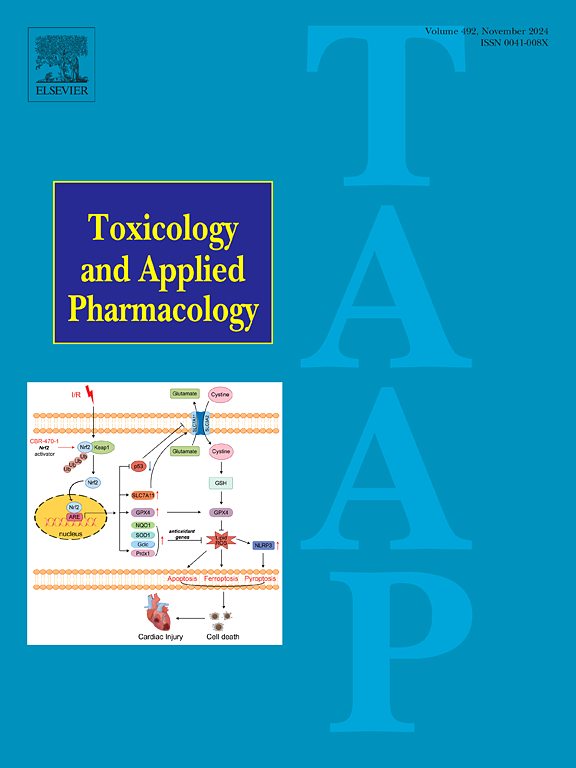Zebrafish larvae as a model for investigating dual effects of fluoride on bone development
IF 3.4
3区 医学
Q2 PHARMACOLOGY & PHARMACY
引用次数: 0
Abstract
Long-term excessive ingestion of fluoride is a severe public health threat globally. Skeletal fluorosis, a significant manifestation of prolonged fluoride exposure, is characterized by aberrant bone structure and alterations in bone function. However, there is currently a shortage of an efficient, fast, and easy-to-operate biological model for application in the field of fluorosis research. Zebrafish larvae, with human - like skeletal traits, high reproduction, rapid development, and transparency, are commonly used in bone disease studies. This study evaluates the potential of zebrafish larvae as a novel model for fluoride-induced bone impairment. Results showed dose-dependent differences in cranial and spinal bone mineralization in zebrafish larvae exposed to sodium fluoride (NaF). The detection results of bone formation-related indicators indicated a considerable increase in alkaline phosphatase (ALP) activity in zebrafish larvae at doses of 0.5 and 1 mg/L. Simultaneously, the expression of critical bone formation proteins (BMP2, and β-catenin) was elevated in the 1 and 4 mg/L groups, which is largely consistent with the results of cranial bone mineralization. Fluoride - exposed zebrafish also showed abnormal bone metabolism markers. The total phosphorus (TP) content in the zebrafish larvae of the 100 mg/L group was markedly reduced. The total calcium (TCa) content in the zebrafish of the NaF group zebrafish was slightly decreased, although the tartrate-resistant acid phosphatase (StrACP) activity increased. In conclusion, different fluoride doses cause osteoporosis and osteosclerosis in zebrafish larvae, linked to enhanced osteogenic and osteoclastic activities and abnormal key bone - forming protein expression.

斑马鱼幼体作为研究氟化物对骨骼发育双重影响的模型
长期过量摄入氟化物是全球严重的公共卫生威胁。氟骨症是长期接触氟化物的一种显著表现,其特征是骨结构异常和骨功能改变。然而,目前缺乏一种高效、快速、易于操作的生物模型应用于氟中毒研究领域。斑马鱼幼体具有与人相似的骨骼特征,繁殖率高,发育迅速,透明,常用于骨病研究。本研究评估了斑马鱼幼体作为氟化物诱导的骨损伤新模型的潜力。结果显示,暴露于氟化钠(NaF)的斑马鱼幼体颅骨和脊柱骨矿化存在剂量依赖性差异。骨形成相关指标检测结果显示,0.5和1 mg/L剂量可显著提高斑马鱼幼鱼碱性磷酸酶(ALP)活性。同时,在1和4 mg/L组中,关键骨形成蛋白(BMP2和β-catenin)的表达升高,这与颅骨骨矿化的结果基本一致。氟暴露斑马鱼的骨代谢指标也出现异常。100 mg/L组斑马鱼幼鱼体内总磷(TP)含量显著降低。NaF组斑马鱼体内总钙(TCa)含量略有下降,但抗酒石酸酸性磷酸酶(StrACP)活性升高。综上所述,不同剂量的氟化物可导致斑马鱼幼鱼骨质疏松和骨硬化,与成骨和破骨活性增强以及关键骨形成蛋白表达异常有关。
本文章由计算机程序翻译,如有差异,请以英文原文为准。
求助全文
约1分钟内获得全文
求助全文
来源期刊
CiteScore
6.80
自引率
2.60%
发文量
309
审稿时长
32 days
期刊介绍:
Toxicology and Applied Pharmacology publishes original scientific research of relevance to animals or humans pertaining to the action of chemicals, drugs, or chemically-defined natural products.
Regular articles address mechanistic approaches to physiological, pharmacologic, biochemical, cellular, or molecular understanding of toxicologic/pathologic lesions and to methods used to describe these responses. Safety Science articles address outstanding state-of-the-art preclinical and human translational characterization of drug and chemical safety employing cutting-edge science. Highly significant Regulatory Safety Science articles will also be considered in this category. Papers concerned with alternatives to the use of experimental animals are encouraged.
Short articles report on high impact studies of broad interest to readers of TAAP that would benefit from rapid publication. These articles should contain no more than a combined total of four figures and tables. Authors should include in their cover letter the justification for consideration of their manuscript as a short article.

 求助内容:
求助内容: 应助结果提醒方式:
应助结果提醒方式:


